PLEASE NOTE: I’m making edits and amendments to the list. Please see the bottom, for some of your additions which have been kindly forwarded to me in the comments. I’m only adding films that have youtube clips, so please send me those links. Thanks.
In a director’s cinematic bag of tricks the long tracking shot is the boldest way of making a statement. It’s the flashiest and most attention-grabbing egotistical way of flexing one’s muscle. In most cases it’s a narcissistic maneuver, “look-at-me” filming technique, but rare ones, the best ones, serve to reflect and further the story in a way that can’t be reflected with traditional editing.
Let’s examine specifically the long ‘tracking’ take which involves extensive and complicated movements of the camera. The fact is filmmakers have been doing long takes since the medium was invented. In fact the first films didn’t have any edits. Perhaps the first most notable film to use long unedited takes for storytelling purposes was Alfred Hitchcock’s “Rope” (1948) which was an entire film shot in real time created by seamless cutting together a series of long 8-10 mins shots made to look like one. In 1948 it was a bold and unprecedented experiment for Hitchcock. The film works because its takes place entirely in one room for 80 minutes, so there was limited movement and lighting changes.
The difficulty arises when the camera is forced to move which complicates the logistics ie. Focus changes, lighting changes and hiding production equipment. And so perhaps the first true, universally-accepted “long tracking shot” is Orson Welles’ opening shot in “Touch of Evil” (1958). This shot was a large step up from Hitchcock’s experiment because of the extensive movement of the camera. Let’s start the list with this masterful one:
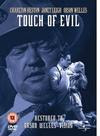 Touch of Evil (1958) – The Opening Shot – dir. Orson Welles
Touch of Evil (1958) – The Opening Shot – dir. Orson Welles
This shot is perhaps the greatest, because it actually has a specific purpose to its length. The shot starts on a bomb being placed in the trunk of a car. The camera follows the car into the street. As the camera moves back we pickup Charlton Heston walking with his date. Though we’re concentrating on Heston, subliminally, as the audience, the bomb is still in our minds. The sheer length of the take heightens the tension for the payoff at the end. It’s important to note that on its first release Universal placed the opening credits over the shot, which severely retracted from its power and suspense. In a later re-release Welles original intention of the scene was re-instated.
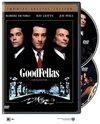 Goodfellas (1990) – The Copacabana – dir. Martin Scorsese
Goodfellas (1990) – The Copacabana – dir. Martin Scorsese
The other granddaddy of the long tracking shot is Ray Liotta and Lorraine Bracco’s walk through the Copacabana in “Goodfellas”. This shot’s serves to put the audience in the point of view of Karen, who is about to be swept off her feet by the temptation of the gangster lifestyle. This introduction to Henry’s world will counterpoint their eventual downfall later in the film. The movement of the camera through the tight spaces and long corridors while maintaining constant dialogue makes this shot an impressive maneuver and a benchmark in cinema.
 Boogie Nights (1997) – The Opening Shot in the Club – dir. Paul Thomas Anderson
Boogie Nights (1997) – The Opening Shot in the Club – dir. Paul Thomas Anderson
All of PT Anderson’s films have a bit (sometimes a lot) of Martin Scorsese in them. Boogie Nights is no exception. The opening shot which starts on a marquee and moves down the street and into a 70’s disco serves to introduce to us the ensemble characters. The shot ends on Mark Wahlberg moving in slo-motion triumphantly introducing Anderson’s star character. As a side note, it was rumoured PT Anderson specifically started the shot on the marquee which reads the title of the movie, to make it impossible for the studio to re-title the movie, which was done with his first film – “Hard Eight” (aka “Sydney”).
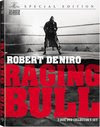 Raging Bull (1980) – Pesci and De Niro Walking to the Fight – dir. Martin Scorsese
Raging Bull (1980) – Pesci and De Niro Walking to the Fight – dir. Martin Scorsese
No youtube clips are online yet for this shot, so I’ll describe it. Starting on Jake La Motta and his brother exiting their dressing room the camera follows them down the hall to the arena, where La Motta is to face the Middleweight Champion for the first time. The shot starts in front the brothers as they make their way through the winding corridors and tunnels, then the camera moves in behind as they enter the arena. As they make their way through the cheering crowd and into the ring, the camera lifts in the air to capture the entire arena in a wide shot. In 1980 the steadycam was a new invention, but Scorsese obviously used it to its full potential as soon as he could get his hands on it. This great shot serves the story because it highlights the greatest moment for La Motta – the fight which won him the Middleweight belt.
 Oldboy (2003) – The Fight with the Hammer – dir. Chan Wook Park
Oldboy (2003) – The Fight with the Hammer – dir. Chan Wook Park
Perhaps not grandiose in its flare or style – the camera only moves back and forth on one axis – but the impact of the action on screen is awe-inspiring. Fight scenes are usually choreographed around the camera so the punches, kicks and falls appear real and violent. But in one majestic tracking shot Chan Wook Park puts to shame most other fight scenes. It’s a dozen baddies with just one guy, one shot? and one hammer.
BTW: The actual long shot doesn’t start until the 30 sec mark of this clip:
 The Player (1992) – The Opening Shot – dir. Robert Altman
The Player (1992) – The Opening Shot – dir. Robert Altman
Another one of the greats. Altman was actually sending up, or paying homage to “Touch of Evil” and actually references it in the dialogue. Unfortunately the clip isn’t available on youtube (yet). So, I’ll describe it. The shot takes place entirely outside on the grounds of a Hollywood studio. The camera tracks, and picks up pieces of conversation from several characters, all setting up and providing the backstory for the film. Altman innovatively overlaps the conversations as he moves from one conversation to the next. He frames the star, Tim Robbins, in an awkward shot through an obscured window to his office. Robbins, as Griffin Mill, is taking a pitch from Buck Henry (writer of “The Graduate”) for “The Graduate 2”. Simply hilarious.
Sorry, the trailer is the best I could do (if anyone can post the opening shot, I’ll re-embed the youtube clip):
 Magnolia (1999) – Entering the Studio – dir. Paul Thomas Anderson
Magnolia (1999) – Entering the Studio – dir. Paul Thomas Anderson
This shot doesn’t quite have the dramatic impact of “Touch of Evil”, “Goodfellas,” or even “Boogie Nights”, but it’s still a marvel. Anderson combines the techniques of Scorsese and Altman to create a dizzying tour of the television studio where much of the drama will go down. It’s raining and Stanley Spector and his dad are late for their game show taping. It’s a tense sequence which moves at a quick pace with much help from Jon Brion’s hypnotic music cue.
 I Am Cuba (1964) – The Rooftop – dir. Mikael Kalatozov
I Am Cuba (1964) – The Rooftop – dir. Mikael Kalatozov
There are half a dozen shots in this film which would make this list. Youtube happens to have the magnificent rooftop shot, which introduces the decadent lifestyle of the Cuban upper class. This shot is important because it provides counterpoint up the plight of the poor farmers and working class Cubans whom we will see in the next scene. Not only is it beautiful but it’s so bold that the shot ends with the camera following a woman into the pool and under the water.
The other shot from the film I would have included is the parade sequence which actually covers a Cuban demonstration by moving up a building, crossing the street in midair, through the top floor of a cigar rolling manufacturer and out the window again moving through mid air. I’m tired just writing this.
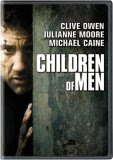 Children of Men (2006) – The Car Chase – dir. Alfonso Cuaron
Children of Men (2006) – The Car Chase – dir. Alfonso Cuaron
Please don’t watch this clip if you haven’t seen the film as it contains major spoilers. Good, now that we got that out of the way, let’s discuss the magnificent chase between Clive Owen and the bunch driving away from the vicious marauders. The shot spins around to show all the characters fighting off the assailants as they drive backwards, avoid bullets and spears etc. No effects were used to create the shot other than a specially rigged car which allowed the camera to hang suspended from the roof and spin and move to capture everyone’s reactions. This shot is one of a series of long extended takes in the film – equally impressive is the rescue of the baby in the refugee camp at the end of the film.
 Hard Boiled (1992) – The Hospital Shootout – dir. John Woo
Hard Boiled (1992) – The Hospital Shootout – dir. John Woo
During the shooting of “Hard Boiled”, towards the end of a long series of days at the hospital, John Woo realized he was running out of time to shoot the remainder of the action sequences. He decided to ‘compromise’ and shoot the remainder of his scene in one shot, the result is the John Woo version of the long take. It’s almost unbelievable the carnage, gunshots, and explosions he creates with just one shot of the camera. You just have to see it to believe it.
 The Protector aka Tom yum goong (2006) – Running Up the Staircase dir. Prachya Pinkaew
The Protector aka Tom yum goong (2006) – Running Up the Staircase dir. Prachya Pinkaew
It’s no “Goodfellas” that’s for sure, in fact the scene is just ridiculous, but the sight of Tony Jaa leaping up the circular staircase, and throwing guys off the side and down the stairs is just so satisfying and audacious it’s worthy of inclusion on the same list as “Touch of Evil” or “Goodfellas”. Wow. Again, you have to see it to believe it.
 Carlito’s Way (1993) – The Subway Chase – dir. Brian De Palma
Carlito’s Way (1993) – The Subway Chase – dir. Brian De Palma
Brian De Palma has used his trump card too many times (ie.”Bonfire of the Vanities”, “Mission to Mars”, “Snake Eyes”) and so I’m inclined to discount his entries. But “Carlito’s Way” is one of the great long take shots. The shot follows a chase between Al Pacino’s character in flight from a trio of mobsters in the NY Subway system. It’s magnificent choreography punctuated by Patrick’s Doyle grand score. Unfortunately no youtube footage exists yet.
 Russian Ark (2002) – The Whole Damn Movie – dir. Aleksandr Sokurov
Russian Ark (2002) – The Whole Damn Movie – dir. Aleksandr Sokurov
Using a sophisticated High Definition camera, Sokurov was able to do what Hitchcock originally wanted to do – stage an entire movie in one shot. “The Russian Ark” is more an artistic experiment than a traditional narrative film, and technically, it’s an achievement, but only a few occasions in the 96-minute running time does the film actually achieve the grandeur the storyline implies. But when it does, it is magnificent – you just have to sit through the really boring parts.
Here’s 10 mins of it:
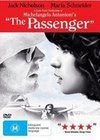 The Passenger (1975) – Locke’s Death – dir. Michelangelo Antonioni
The Passenger (1975) – Locke’s Death – dir. Michelangelo Antonioni
Warning this clip contains spoilers. A rare feat is a final long take shot. “The Passenger’s” final shot is a 7-min long opus which starts inside a hotel room, where we see Jack Nicholson’s character lying on a bed, the camera then pushes in to catch the action outside. It actually goes through the window and outside into the courtyard. By the end of the shot, the camera has turned itself around and is looking into the room where we discover Jack, while out of our sight, has just been murdered. It’s one of the more sly and devious long take shots of this list.
Of course dozens of other films have used long takes including Gasper Noe’s “Irreversible”, Godard’s “Weekend”, and many of Tarkovsky’s and Theo Angelopolis’s films. This is by no means comprehensive. Please chime in your favourites.
Thanks.
ADDITIONS AND AMENDMENTS:
Due to the overwhelming responses I’ve added some more clips. Please see below.
 Satantango (1994) Walking to the Police Station dir. Bela Tarr
Satantango (1994) Walking to the Police Station dir. Bela Tarr
Bela Tarr is a master, and sadly I’m not familiar enough of the work to provide ample commentary, but this clip is a beautiful shot:
Weekend (1967) Tracking Across the Farm Dir. Jean-Luc Godard

Jean-Luc Godard’s classic, “Weekend” features a series of long tracking shots, as a kind reader pointed out, ‘before it was in vogue’. Check this one out.

Breaking News (2004) – The opening shootout – Dir. Johnny To
This highly stylized crime classic opens with a wild shoot out with the police, of course, all in one take. Shades of De Palma on this one.
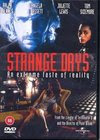 Strange Days (1995) – The Opening POV Chase – Dir. Kathryn Bigelow
Strange Days (1995) – The Opening POV Chase – Dir. Kathryn Bigelow
Kathryn’s Bigelow’s opening shot is taken from the POV of a robber escaping a robbery. It’s entirely handheld and therefore very jittery and nausea-induces. But it’s lengthy. Judge for yourself.
 Nostalghia (1983) – Carrying the Candle – Dir. Andrei Tarkovsky
Nostalghia (1983) – Carrying the Candle – Dir. Andrei Tarkovsky
The Russians/Soviets seem to love their long takes. Here’s a head-turner from Tarkovsky’s “Nostalghia”, which features a man’s numerous attempts to carry a lit candle across a courtyard. It’s not technically amazing, but it’s fascinating how it draws you in. It’s a remarkable example of determination.

Elephant (2003) – John’s Walk Through the Halls and Outside – Dir. Gus Van Sant
Elephant has about a dozen long steadycam shots. Here is a key shot, from the brilliant Harris Savides, which shows John walking through the halls and then outside the school. The movement and camera exposure from inside to outside is seemless. Potential SPOILERS here as well.
 Kill Bill Vol 1 (2003) – The 5,6,7,8’s – Dir. Quentin Tarantino
Kill Bill Vol 1 (2003) – The 5,6,7,8’s – Dir. Quentin Tarantino
Here’s another one of Tarantino’s De Palma homages – the famous 5,6,7,8’s shot. Robert Richardson is at the helm photographically on this one. Enjoy.
 Serenity (2005) – The Opening Credits/Walk Though the Ship – Dir. Joss Whedon
Serenity (2005) – The Opening Credits/Walk Though the Ship – Dir. Joss Whedon
By popular demand, here’s the opening of “Serenity”. Capt Mal starts out in the cockpit, then moves back through the rest of the ship introducing us to all the characters. A well-hidden cut occurs midway, but it’s two impressive long takes put together.
Snake Eyes (1998) – The Opening – Dir. Brian De Palma
Ok Ok Ok. I really hate this film, but people wanted this shot up here. Here’s 10 minutes of the opening of Snake Eyes, whose opening shot lasts 20mins or so – too long for a 1000 mag of film, so I think there’s a cut in there.
Great Expectations (1999) Kissing in the Rain – Dir. Alfonso Cuaron
Alfonso loves his long takes. This one cleverly spliced a few shots together, but is a great moment nonetheless. Enjoy.
Nine Lives (2005) – William Fichtner Sequence – Dir. Rodrigo Garcia
Rodrigo Garcia’s “Nine Lives” is composed of nine different each showing a part of a woman’s life. This one features the great character actor William Fichtner showcased like he should.
Irreversible (2002 ) – At the Club – Dir. Gaspar No?
Gaspar No?’s notorious film with Vincent Cassel and Monica Belluci. Here are a couple of segments mended together over a span of a full day and night. All segments are long tracking shots. Warning this clip contains some graphic material. Viewer discreti?. Ahh just watch it, it won’t kill you.
Don’t worry, there’s more to come. Please keep checking back. Thanks.
Awesome post! These tracking shots are really astounding!
Gotta add PANIC ROOM though. It’s a masterpiece!
http://fincherfanatic.blogspot.com
You’ve *still* missed several massively important long tracking shots.
The shot introducing the bureaucracy in *Brazil* is HUGE. Gilliam pulls it off masterfully, of course. The motion. The music. The speed of the camera. The length of the walkways…
And how could you miss the opening shot inside of Rick’s in *Casablanca*!?
The GoodFellas clip you linked has since been removed.
This link should work now:
http://www.youtube.com/watch?v=ueX7XsmKjsY
To Violetta:
Thanks for your reminding.
I know you mentioned it, but the long shot at the end of Children of Men is even more amazing than the car chase. Good grief, it’s incredible.
And, what, no Renoir?
you’re forgetting one of the best tracking shots ever made!!! Check out atonement, the beach scene
The Touch of evil video isn’t available anymore. Watch it HERE
you left out the amazing long take in “vertigo”, when scotty enters the restaurant and the camera comes to rest on madeline! also, the longs takes in hitchcock’s “rope”
the short but quite good tracking shot at the end of the Australian film Next of Kin is worth checking out.
The shot follows a girl running out of a gas station, into a truck, drives away and turns round slowly to see the gas station explode.
The camera doesnt pick up the initial explosion but catches it reflected in a road sign as it turns round, only to get the fireball of the explosion.
In the documentary ‘not quite hollywood’ the director of Next of Kin tells of how the explosion went off too soon but the overall effect of it works so well and looks deliberate.
Probably best to see not quite hollywood as its easyer to get hold of if you want to see the shot
What about the track scene from Sean of the Dead when he walks through the streets not even noticing the zombies?
here’s the opening shot of the player: http://www.youtube.com/watch?v=0epB5Z6ijpk
I am enormously worried regarding the 2012 election. When I think about everything that is occuring in Iraq, Afghanistan, and the Middle East (not to mention the economy) we definitely should be looking for a good leader. I’m far from convinced that President Obama or any of the Republican challengers thus far have the experience or skills necessary to get the job done the way it has to be accomplished. Being president of this country is an powerfully challenging job. Is there someone out there with the experience, skill, and moral conviction to do the job?
2004’s Pride and Prejudice sees Joe Wright’s effective tracking shot at the Netherfield Ball. Moving between dancing cast members, dropping them off then picking them up again throughout the party, finally stopping on Lizzy (Keira Knightley) as she recedes into shadows to contemplate the ridiculous characters that are her family. Doesn’t belong in the top ten or anything but it is mentionable, certainly.